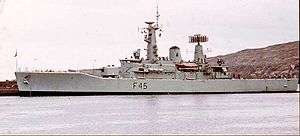HMS Minerva (F45)
 HMS Minerva in April 1970 | |
| History | |
|---|---|
| Name: | HMS Minerva (F45) |
| Operator: | Royal Navy |
| Builder: | Vickers Armstrong[1][2] |
| Laid down: | 25 July 1963[1] |
| Launched: | 19 December 1964[1][2] |
| Commissioned: | 14 May 1966[1][2] |
| Decommissioned: | March 1992 |
| Nickname(s): | "Fighting 45"[3] |
| Fate: | Sold for scrap July 1993 |
| General characteristics | |
| Class and type: | Leander class frigate |
HMS Minerva (F45) was a Leander-class frigate of the Royal Navy.
History
She was built by Vickers Armstrong.[1][4] She was launched on 19 December 1964,[1][2] and commissioned on 14 May 1966.[1][2]
In 1968, Minerva deployed to the West Indies during some troubles there, operating from Bermuda. Island hopping was carried to show the"flag". In 1970, Minerva, like many other British vessels including other Leanders, deployed on Beira Patrol, an operation designed to prevent oil from reaching the landlocked Rhodesia via Mozambique, before visiting various ports around Asia and the Pacific. The following year, Minerva deployed on her second Beira Patrol which proved relatively quiet.
In November 1972, the Prince of Wales joined Minerva. The following year, in February, Minerva, along with the Prince, deployed to the Caribbean. While there Minerva was involved in a number of exercises, including Exercise "Rum Punch" at Puerto Rico, involving British and American forces. The ship returned to the UK in November. Minerva then took part in the second cod war, in early 1973.
In 1975, Minerva returned to the Caribbean, performing a variety of duties there. Between December 1975 and March 1979, Minerva underwent modernisation, including the addition of Exocet missiles. While she was undergoing post refit trials Minerva suffered a Stbd boiler explosion which destroyed both boiler uptakes forcing her to be towed to Chatham Dockyard for repairs. In December the following year, a dockyard crane smashed into Minerva during a storm, causing damage to the ship's superstructure. In 1980, Minerva deployed to the Mediterranean where she carried out exercises with other NATO warships. While there Minerva got involved in the Cold War when she shadowed the Kiev, the nameship of a three-ship class of large aircraft carriers. In 1981, Minerva was involved in further exercises in the Persian Gulf.
In 1982 during the Falklands War Minerva was part of the 'Bristol Group' and thus joined the war rather late, not reaching the Falkland Islands until the 26 May. While there, Minerva performed a number of duties, including escort for other vessels. On June 1st 1982 her radar detected an Argentinian C-130 and vectored a flight of patrolling Sea Harriers towards it. The reconnaissance plane was intercepted and shot down. [5] Minerva suffered no damage during her deployment during the Falklands War and she returned to Devonport in September, crowds greeting her upon her return.
In November, Minerva accidentally rammed the Rothesay-class frigate Yarmouth. In late 1984, Minerva returned to the South Atlantic on a deployment that encompassed all British South Atlantic territories, a deployment which lasted into 1985. She continued service throughout the rest of the 1980s, seeing much of the world, including being involved in a number of exercises with NATO allies and acting as patrol ship in a number of deployments. By the early 1990s, Minerva's age was showing, and in March 1992, her long and eventful career came to an end. The following year Minerva was sold for scrap.
Commanding officers
| From | To | Captain |
|---|---|---|
| 1978 | 1980 | Captain Benjamin Bathurst RN |
| 1989 | 1991 | Commander Christopher Clay RN |
| 1991 | 1992 | Commander Duncan Campbell MacGregor Fergusson RN |
References
- 1 2 3 4 5 6 7 http://www.hmsminerva.info/itinerary.htm
- 1 2 3 4 5 http://www.oldships.org.uk/SHIPS/SHIP_DETAILS/MINERVA_DETAIL.htm
- ↑ http://smmlonline.com/archives/VOL2113.txt
- ↑ http://www.oldships.org.uk/SHIPS
- ↑ "FlightTC-63". Flight Safety Foundation. 21 December 2015. Retrieved 21 December 2015.
Publications
- Colledge, J. J.; Warlow, Ben (2006) [1969]. Ships of the Royal Navy: The Complete Record of all Fighting Ships of the Royal Navy (Rev. ed.). London: Chatham Publishing. ISBN 978-1-86176-281-8. OCLC 67375475.
- Marriott, Leo, 1983. Royal Navy Frigates 1945-1983, Ian Allen Ltd, Surrey. ISBN 978-0-7110-1322-3
External links
| Wikimedia Commons has media related to HMS Minerva (F45) (ship, 1964). |